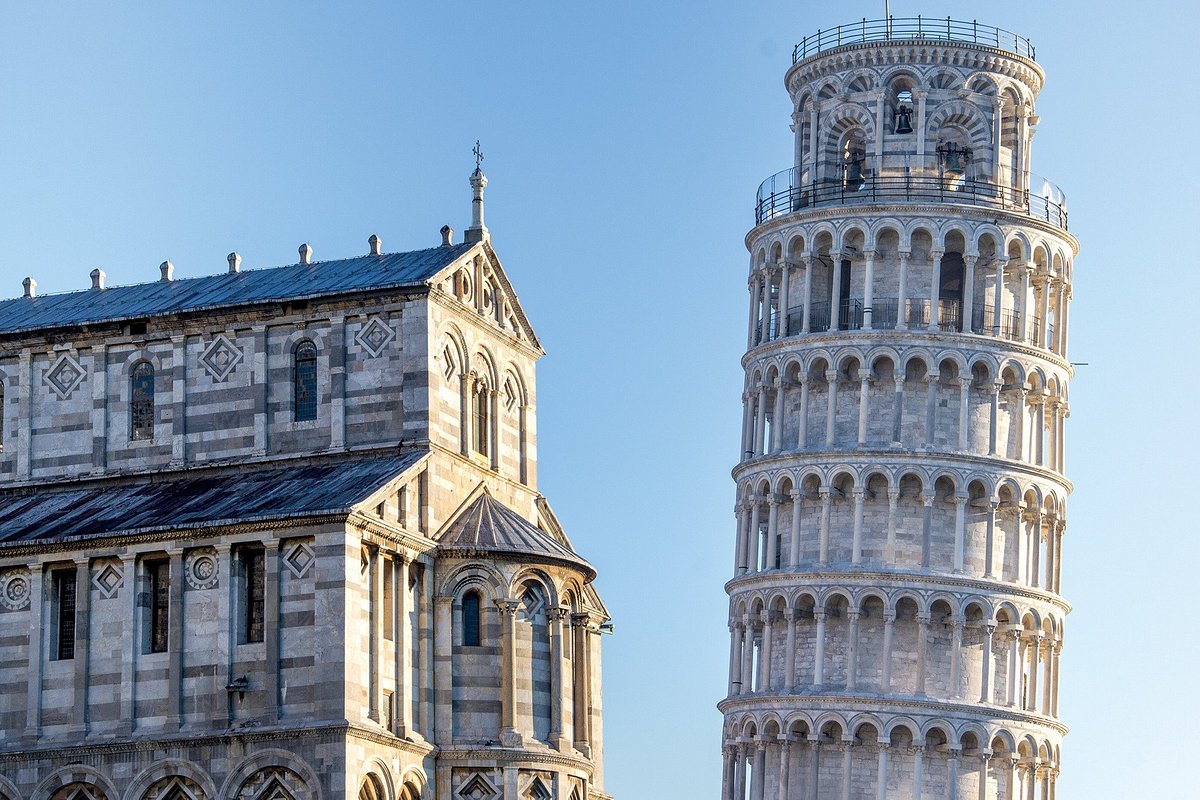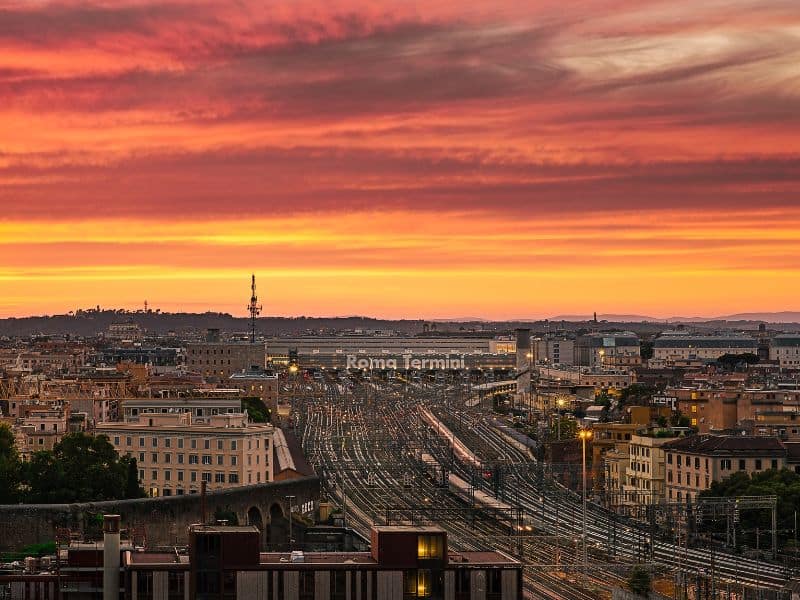Rome, with its ancient history, iconic landmarks, and vibrant atmosphere, is well known as a captivating destination for travelers. Yet, the allure of Italy extends far beyond its capital, and most of it is well within reach of Rome.
Fortunately, Rome’s efficient and extensive rail network makes it convenient to embark on enriching day trips to nearby cities and towns. So let’s delve into the enchanting destinations that beckon just a train ride away from Roma.
Day Trips from Rome By Train
Florence (Firenze)
Florence, a mere 90-minute train journey from Rome, beckons travelers with its unparalleled artistic heritage and architectural splendors. The Uffizi Gallery, a cultural beacon, houses an extensive collection of Renaissance masterpieces, including Botticelli’s “The Birth of Venus” and da Vinci’s “Annunciation.” The gallery itself is a marvel, occupying the historic Uffizi complex.
Ponte Vecchio, Florence’s oldest bridge, spans the Arno River and is adorned with shops that have been selling jewelry, art, and souvenirs for centuries. Walking across this medieval bridge offers not only a shopping experience but also panoramic views of the river.

Florence Cathedral, or Duomo, is an architectural triumph dominating the city’s skyline. Its terracotta dome, designed by Brunelleschi, is an iconic symbol. Climbing to the top of the cathedral provides breathtaking views of Florence and the surrounding Tuscan hills.
Piazzale Michelangelo, a hilltop square, offers a postcard-perfect panorama of the city. It’s a popular spot for both locals and tourists to enjoy the sunset and capture the essence of Florence in a single gaze.
Beyond its artistic treasures, Florence’s Mercato Centrale is a lively market where visitors can indulge in authentic Tuscan cuisine. From fresh produce and local cheeses to artisanal pasta and gelato, the market is a culinary delight.
- Travel Time: Approximately 1 hour and 30 minutes.
- Highlights: Uffizi Gallery, Ponte Vecchio, Florence Cathedral (Duomo), and Piazzale Michelangelo.
Pisa
Pisa, a picturesque city reachable by a leisurely two-hour train ride from Rome, is synonymous with its iconic Leaning Tower. The Leaning Tower of Pisa, a freestanding bell tower of the cathedral, is an architectural marvel that began tilting during its construction due to unstable soil. The tower, along with the Pisa Cathedral and Baptistery, forms the UNESCO-listed Piazza dei Miracoli (Square of Miracles), a captivating ensemble of Romanesque architecture.

Beyond the famous tower, Pisa’s historic center beckons with its charming streets and lively squares. The Pisa Cathedral, a masterpiece adorned with intricate sculptures and mosaics, stands as a testament to Romanesque grandeur. The Baptistery, known for its exceptional acoustics, showcases a blend of Gothic and Romanesque styles.
Pisa’s historic significance extends beyond its landmarks. The city, once a powerful maritime republic, boasts a rich maritime history evident in its grand palaces and medieval churches. The scenic Arno River adds to the city’s charm, with its picturesque bridges and riverside promenades.
Strolling through Pisa, visitors can explore the Campo Santo, a monumental cemetery with Gothic arcades, and the Palazzo Blu, an art museum hosting exhibitions by renowned artists. Pisa offers a delightful blend of architectural marvels, historical depth, and a relaxed ambiance, making it a must-visit destination for those seeking a balance of iconic landmarks and authentic Italian charm.
- Travel Time: Approximately 2 hours.
- Highlights: Leaning Tower of Pisa, Piazza dei Miracoli, and Pisa Cathedral.
Naples (Napoli)
Just over an hour from Rome by train, Naples immerses visitors in Southern Italian culture. Its historic city center, a UNESCO World Heritage site, is a maze of narrow streets and vibrant markets. Naples Cathedral, dedicated to Saint Januarius, houses precious relics, and the nearby Royal Palace showcases opulent architecture and historic artifacts.
A short stroll from the cathedral leads to the Royal Palace of Naples, an architectural gem showcasing opulent rooms, royal apartments, and historic artifacts. The palace’s grandeur reflects the city’s royal heritage, and its sprawling gardens offer a peaceful retreat.

Naples is not only a city of history but also a culinary haven. It is widely hailed as the birthplace of pizza, and a visit here is incomplete without savoring a Neapolitan pizza from one of the local pizzerias. The city’s culinary scene extends beyond pizza, with street food, seafood, and traditional pastries like sfogliatella and babà contributing to the gastronomic experience.
Beyond the historical and culinary delights, Naples exudes a unique energy found in its vibrant street life and local traditions. A walk along Spaccanapoli, the straight and narrow historic street that cuts through the heart of the old city, unveils churches, shops, and glimpses of daily Neapolitan life. The city’s authenticity and unfiltered charm make it an essential stop for those seeking an immersive experience in Italian culture.
In addition to its immediate attractions, Naples serves as a convenient launchpad for exploring the nearby Amalfi Coast, Sorrento, and the islands of Capri and Ischia. The strategic location and dynamic atmosphere make Naples a captivating destination that seamlessly blends history, culture, and the lively spirit of Southern Italy.
A short journey from Naples leads to Pompeii (see below), an ancient city frozen in time by the eruption of Mount Vesuvius in 79 AD, offering a unique glimpse into Roman life. Naples’ culinary scene, especially its world-famous pizza, adds a flavorful touch to the visit.
- Travel Time: Approximately 1 hour and 10 minutes.
- Highlights: Pompeii (archaeological site), Mount Vesuvius, Naples Cathedral, and the Royal Palace of Naples.
Pompeii and Herculaneum
Pompeii and Herculaneum, both ancient Roman cities destroyed and preserved by the eruption of Vesuvius, provide a remarkable archaeological experience. Pompeii’s well-preserved ruins include temples, theaters, and villas, offering insights into daily life in the Roman Empire.

Herculaneum, though smaller, boasts better-preserved buildings and artifacts, providing a more intimate look into the past. The eruption’s volcanic ash solidified around structures, preserving them for centuries. Visiting these sites unveils the tragic history and architectural marvels of these once-thriving cities.
- Travel Time: Approximately 1 hour and 10 minutes to Naples, then a short train or bus ride to the archaeological sites.
- Highlights: Explore the well-preserved ruins of the ancient Roman cities of Pompeii and Herculaneum.
Orvieto
A 75-minute train ride from Rome takes you to Orvieto, perched atop a volcanic tuff cliff. Orvieto Cathedral, a masterpiece of Italian Gothic architecture, features stunning frescoes by Luca Signorelli and Fra Angelico. St. Patrick’s Well, an engineering marvel, was dug by hand and served as a water source during sieges.
Orvieto’s underground tunnels, remnants of Etruscan and medieval structures, provide a cool escape and a glimpse into the city’s layered history. The town’s charming Piazza della Repubblica invites visitors to savor local wines and delicacies while enjoying the laid-back atmosphere.
- Travel Time: Approximately 1 hour and 15 minutes.
- Highlights: Orvieto Cathedral, St. Patrick’s Well, and Orvieto Underground.
Assisi
Assisi, a two-hour train journey from Rome, is synonymous with the life of Saint Francis. The Basilica of San Francesco, a UNESCO World Heritage site, houses masterpieces by Giotto and Cimabue depicting the life of the saint.
The town’s spiritual ambiance extends to Santa Chiara and the Basilica di Santa Maria degli Angeli, built around the Porziuncola, a small chapel where the Franciscan movement began. Assisi’s medieval streets and alleys create a tranquil atmosphere, perfect for reflection and appreciation of its cultural and religious significance.
- Travel Time: Approximately 2 hours.
- Highlights: Basilica of San Francesco, Basilica of Santa Chiara, and the historic town center.
Tivoli
A half-hour train journey transports visitors to Tivoli, renowned for its Renaissance villas and ancient Roman ruins. Villa d’Este, a UNESCO World Heritage site, boasts impressive terraced gardens adorned with fountains and sculptures. Hadrian’s Villa, a vast archaeological complex, served as a retreat for the Roman Emperor Hadrian.
The town itself offers a relaxed ambiance, with charming cafes and shops lining the streets. Tivoli provides a blend of natural beauty and historical grandeur, making it a perfect day trip destination.
- Travel Time: Approximately 30 minutes.
- Highlights: Villa d’Este (Renaissance villa with beautiful gardens and fountains), Hadrian’s Villa (Villa Adriana), and the town center.
Ostia Antica
Ostia Antica, just 30 minutes from Rome by train, offers a well-preserved glimpse into the life of an ancient Roman port city. The archaeological site features a theater, forum, and well-preserved residential buildings. Ostia Antica served as a vital hub for trade and commerce, with warehouses, shops, and apartment buildings lining its streets. Exploring the site provides a nuanced understanding of daily life, showcasing the city’s social, economic, and cultural aspects. The proximity to Rome makes it an accessible and immersive historical experience without the crowds often found at larger archaeological sites.
- Travel Time: Approximately 30 minutes.
- Highlights: Ancient Roman ruins, including a well-preserved theater, forum, and residential buildings.
Siena
Siena, 90 minutes from Rome by train, is renowned for its medieval charm and the iconic Piazza del Campo. The Palio, a historic horse race held twice a year in the piazza, adds a dynamic cultural element to the city. Siena Cathedral, a masterpiece of Italian Gothic architecture, features intricate sculptures and paintings. The historic center’s narrow streets reveal quaint shops, cafes, and the vibrant local culture. Siena’s blend of history, art, and traditions offers a unique experience for those seeking a deeper understanding of Tuscan heritage.
- Travel Time: Approximately 1 hour and 30 minutes.
- Highlights: Piazza del Campo, Siena Cathedral, and the medieval streets of the historic center.
Civita di Bagnoregio
Civita di Bagnoregio, accessible by a 90-minute train journey to Orvieto followed by a short bus ride, is a captivating medieval town perched on a tufa hill. Known as the “dying town” due to erosion, Civita’s charm lies in its timeless streets, medieval architecture, and breathtaking views of the surrounding valley.
The town’s Cathedral of San Donato and the Etruscan rock-hewn caves add layers to its historical narrative. Civita di Bagnoregio provides a serene and off-the-beaten-path day trip, offering a peaceful escape from the bustling city life.
- Travel Time: Approximately 1 hour and 30 minutes to Orvieto, then a bus ride to Civita di Bagnoregio.
- Highlights: A picturesque medieval hill town with stunning views, known as the “dying town.”
Remember to check the current train schedules and consider purchasing tickets in advance to ensure a smooth day trip. Additionally, travel times are approximate and may vary based on the type of train and specific routes available.
Recent Posts
Here are seven great hotels in Helsinki for train travelers. All seven hotels are located near the train station in Helsinki, making them all convenient travel options that will be hard to beat...
Train Trips from Venice: Exploring Italy by Rail Italy is a country of breathtaking landscapes, rich history, and vibrant culture, and there's no better way to explore its treasures than by train....
